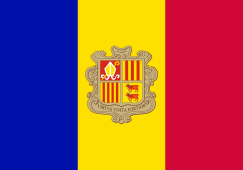Demographics of Andorra
This article is about the demographic features of the population of Andorra, including population density, ethnicity, education level, health of the populace, economic status, religious affiliations and other aspects of the population.

Andorrans, who are ethnically Catalans, are a minority in their own country; Spanish, French, and Portuguese residents make up 67.7% of the population.
| Historical populations | ||
|---|---|---|
| Year | Pop. | ±% p.a. |
| 1950 | 6,176 | — |
| 1960 | 8,392 | +3.11% |
| 1970 | 19,545 | +8.82% |
| 1980 | 35,460 | +6.14% |
| 1990 | 54,507 | +4.39% |
| 2000 | 65,844 | +1.91% |
| 2010 | 85,015 | +2.59% |
| 2015 | 78,014 | −1.70% |
| Source: Departament d'Estadística d'Andorra[1] | ||
The national language is Catalan, a Romance language in the Western Romance group. It is spoken by more than 12 million people in the nearer territories. Spanish, French, and Portuguese also are spoken.
Andorrans live in seven urbanized valleys that form Andorra's political districts the seven parròquies (parishes):
Vital statistics
From state sources:[2]
| Average population | Live births | Deaths | pop. growth rate | Crude birth rate (per 1000) | Crude death rate (per 1000) | yearly change | Fertility rate | |
|---|---|---|---|---|---|---|---|---|
| 1948 | 5,500 | 92 | 58 | 16.6 | 10.5 | |||
| 1949 | 5,800 | 85 | 48 | 14.6 | 8.2 | |||
| 1950 | 6,100 | 94 | 61 | 7.99% | 15.5 | 10.1 | ||
| 1951 | 6,200 | 104 | 63 | 8.00% | 16.7 | 10.1 | ||
| 1952 | 6,100 | 98 | 49 | 8.34% | 16.1 | 8.0 | ||
| 1953 | 5,700 | 101 | 53 | 8.46% | 17.6 | 9.3 | ||
| 1954 | 5,500 | 96 | 51 | 8.43% | 17.3 | 9.2 | ||
| 1955 | 5,800 | 108 | 55 | 8.32% | 18.5 | 9.4 | 608 | |
| 1956 | 6,200 | 110 | 61 | 8.14% | 17.7 | 9.8 | ||
| 1957 | 6,300 | 111 | 47 | 7.95% | 17.6 | 7.4 | ||
| 1958 | 6,800 | 138 | 55 | 7.75% | 20.4 | 8.1 | ||
| 1959 | 7,200 | 157 | 57 | 7.56% | 21.9 | 7.9 | ||
| 1960 | 7,800 | 180 | 73 | 7.36% | 23.0 | 9.3 | 836 | |
| 1961 | 8,700 | 185 | 61 | 7.17% | 21.3 | 7.0 | ||
| 1962 | 9,600 | 242 | 72 | 6.96% | 25.1 | 7.5 | ||
| 1963 | 10,800 | 262 | 75 | 6.72% | 24.2 | 6.9 | ||
| 1964 | 11,800 | 275 | 77 | 6.46% | 23.3 | 6.5 | ||
| 1965 | 12,900 | 308 | 75 | 6.19% | 23.9 | 5.8 | 1,027 | |
| 1966 | 14,000 | 292 | 88 | 5.9% | 20.9 | 6.3 | ||
| 1967 | 15,000 | 330 | 93 | 5.64% | 22.1 | 6.2 | ||
| 1968 | 16,400 | 375 | 96 | 5.46% | 22.9 | 5.9 | ||
| 1969 | 17,700 | 390 | 113 | 5.36% | 22.0 | 6.4 | ||
| 1970 | 18,900 | 395 | 102 | 5.28% | 20.9 | 5.4 | 1,146 | |
| 1971 | 20,000 | 414 | 91 | 5.28% | 20.7 | 4.5 | ||
| 1972 | 21,000 | 487 | 110 | 5.21% | 23.2 | 5.2 | ||
| 1973 | 22,300 | 475 | 132 | 4.98% | 21.3 | 5.9 | ||
| 1974 | 23,900 | 545 | 116 | 4.54% | 22.8 | 4.8 | ||
| 1975 | 25,700 | 515 | 88 | 4.04% | 20.1 | 3.4 | 1,285 | |
| 1976 | 26,700 | 469 | 143 | 3.5% | 17.6 | 5.4 | ||
| 1977 | 27,500 | 469 | 122 | 3.11% | 17.1 | 4.4 | ||
| 1978 | 29,100 | 441 | 140 | 2.98% | 15.2 | 4.8 | ||
| 1979 | 30,700 | 420 | 110 | 3.18% | 13.7 | 3.6 | ||
| 1980 | 33,400 | 577 | 153 | 3.57% | 17.3 | 4.6 | 1,071 | |
| 1981 | 36,600 | 560 | 156 | 3.99% | 15.3 | 4.3 | ||
| 1982 | 38,900 | 630 | 127 | 4.29% | 16.2 | 3.3 | ||
| 1983 | 40,800 | 563 | 157 | 4.47% | 13.8 | 3.8 | ||
| 1984 | 42,200 | 472 | 164 | 4.51% | 11.2 | 3.9 | ||
| 1985 | 43,700 | 557 | 165 | 4.43% | 12.8 | 3.8 | 1,707 | |
| 1986 | 45,800 | 547 | 179 | 4.3% | 11.9 | 3.9 | ||
| 1987 | 47,700 | 527 | 176 | 4.18% | 11.0 | 3.7 | ||
| 1988 | 49,500 | 572 | 206 | 4.07% | 11.6 | 4.2 | ||
| 1989 | 50,700 | 634 | 209 | 4.0% | 12.5 | 4.1 | ||
| 1990 | 52,700 | 628 | 191 | 3.93% | 11.9 | 3.6 | 1,983 | |
| 1991 | 56,800 | 678 | 217 | 3.97% | 11.9 | 3.8 | ||
| 1992 | 60,300 | 729 | 219 | 3.93 | 12.1 | 3.6 | ||
| 1993 | 63,400 | 723 | 211 | 3.56% | 11.4 | 3.3 | ||
| 1994 | 64,800 | 704 | 184 | 2.79% | 10.9 | 2.8 | ||
| 1995 | 64,100 | 702 | 219 | 1.83% | 11.0 | 3.4 | 1,869 | |
| 1996 | 64,200 | 700 | 197 | 0.68% | 10.9 | 3.1 | ||
| 1997 | 64,900 | 730 | 197 | -0.22% | 11.2 | 3.0 | ||
| 1998 | 65,600 | 781 | 235 | -0.4% | 11.9 | 3.6 | ||
| 1999 | 65,900 | 823 | 207 | 0.43% | 12.5 | 3.1 | ||
| 2000 | 65,900 | 747 | 259 | 1.93% | 11.3 | 3.9 | 309 | |
| 2001 | 66,100 | 777 | 237 | 3.63% | 11.8 | 3.6 | ||
| 2002 | 66,700 | 749 | 218 | 4.83% | 11.2 | 3.3 | ||
| 2003 | 69,700 | 721 | 221 | 5.26% | 10.3 | 3.2 | ||
| 2004 | 74,600 | 814 | 281 | 4.75% | 10.9 | 3.8 | ||
| 2005 | 77,700 | 828 | 276 | 3.68% | 10.7 | 3.6 | 3,165 | |
| 2006 | 79,900 | 843 | 260 | 2.65% | 10.6 | 3.3 | ||
| 2007 | 82,200 | 826 | 230 | 1.81% | 10.1 | 2.8 | ||
| 2008 | 83,800 | 875 | 237 | 0.87% | 10.4 | 2.8 | ||
| 2009 | 84,300 | 838 | 272 | 0.2% | 9.9 | 3.2 | ||
| 2010 | 85,015 | 828 | 239 | -0.17% | 9.7 | 2.8 | 639 | 1.41 |
| 2011 | 78,115 | 793 | 275 | -2.48% | 10.2 | 3.5 | 1.38 | |
| 2012 | 76,246 | 737 | 303 | -3.66% | 9.7 | 4.0 | 1.33 | |
| 2013 | 75,902 | 637 | 239 | -4.3% | 9.1 | 3.4 | 1.18 | |
| 2014 | 72,786 | 639 | 276 | -4.11% | 9.0 | 3.9 | 1.21 | |
| 2015 | 70,473 | 659 | 282 | -3.18 | 9.2 | 3.9 | -2,789 | 1.23 |
| 2016 | 73,105 | 634 | 310 | -1.86% | 8.7 | 4.2 | 1.19 | |
| 2017 | 79,474 | 588 | 323 | 7.8 | 4.3 | 1.13 |
CIA World Factbook demographic statistics
The following demographic statistics are from the CIA World Factbook, unless otherwise indicated.
Population
- 85,458 (July 2014 est.)
- country comparison to the world: 201
Age structure
- 0-14 years: 15.3% (male 6,708/female 6,379)
- 15-24 years: 9.2% (male 4,078/female 3,766)
- 25-54 years: 48.7% (male 21,395/female 20,231)
- 55-64 years: 12.5% (male 5,756/female 4,957)
- 65 years and over: 14.3% (male 6,145/female 6,043) (2014 est.)
Median age
- Total: 42.4 years
- Male: 42.6 years
- Female: 42.3 years (2014 est.)
Urbanization
- Urban population: 89% of total population (2008)
- Rate of urbanization: -0.2% annual rate of change (2005-10 est.)
Sex ratio
- At birth: 1.07 male(s)/female
- Under 15 years: 1.06 male(s)/female
- 15-64 years: 1.09 male(s)/female
- 65 years and over: 0.98 male(s)/female
- Total population: 1.07 male(s)/female (2009 est.)
Infant mortality rate
- Total: 3.76 deaths/1,000 live births
- country comparison to the world: 212
- Male: 3.78 deaths/1,000 live births
- Female: 3.74 deaths/1,000 live births (2009 est.)
Life expectancy at birth
- Total population: 82.65 years
- Country comparison to the world: 7
- Male: 80.51 years
- Female: 84.92 years (2014 est.)
Total fertility rate
- 1.38 children born/woman (2014 est.)
- country comparison to the world: 2.10
HIV/AIDS
- Adult prevalence rate: NA%
- People living with HIV/AIDS: NA%
- HIV/AIDS - deaths: NA%
Nationality
| Part of a series on the |
| Culture of Andorra |
|---|
 |
| History |
| People |
| Languages |
|
Mythology and folklore |
| Cuisine |
| Festivals |
| Religion |
|
Music and performing arts |
| Sport |
|
Monuments |
|
Symbols |
|
- Noun: Andorran(s)
- Adjective: Andorran
Ethnic groups
- Andorrans 33%
- Spanish 23% (who are divided into Spanish and Catalan speakers)
- Portuguese 21%
- French 17%
- Arabs 3% (North African immigrants)
- Other 3% (1998) (including Britons and Italians)
- (These figures correspond to citizenship and not mother tongue or nationality.)
Religions
Languages
- Catalan (official), Spanish, French, Portuguese and English
Literacy
- Definition: NA
- Total population: 100%
- Male: 100%
- Female: 100%
School life expectancy (primary to tertiary education)
- Total: 11 years (2006)
Education expenditure
- 2.3% of total GDP (2006)
- country comparison to the world: 162
References


